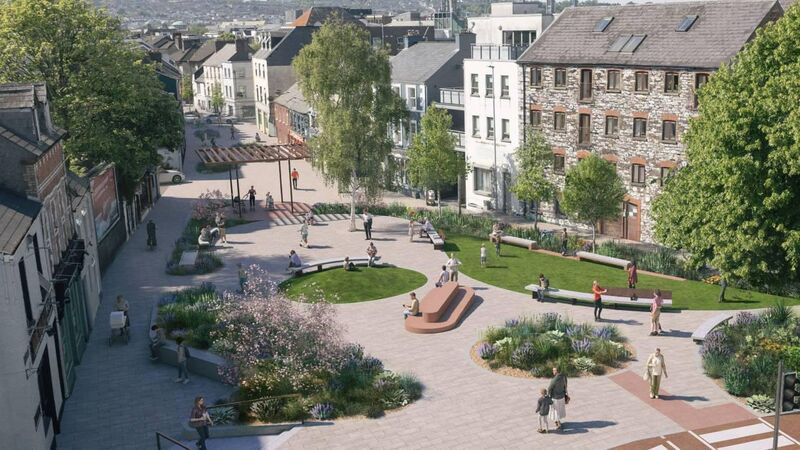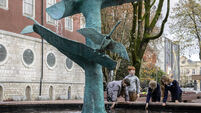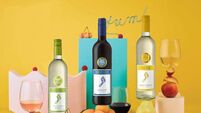Cork Views: Fewer cars will make new Cork city village such an idyllic spot

A city that moves at the pace of its people rather than its cars is a city that understands progress.
This is what we need as Cork moves forward with its next ambitious phase of development
Cork City Council has exciting, innovative plans for a village within the historic core of the city. But the plans need to retain their ambition to achieve their full potential.
Let’s not give in to the pressure of the need for car space. Let’s follow the template of other major European cities who have sacrificed car space for people space and are reaping the rewards in stronger communities, cleaner air, less noise and improved health and wellbeing.
Public consultation for the Mary Street, Douglas Street, and White Street public realm enhancement is now open as Cork City Council aims to restore its ‘village within the city’. The aim is to begin construction in late 2026 or early 2027.
Proposed upgrades to the narrow streets, typically congested with slow -moving traffic, include pedestrian zones, one-way traffic systems, removal of parking spaces, enhanced public spaces and a new pocket park at the eastern end of Douglas Street. A number of the streets are proposed to be one-way for cars and expanded cycle facilities.
An upgrade of Red Abbey Square is proposed with traffic calming measures along the street, enhanced landscaping, and lighting. The TFI biking scheme is proposed for Abbey Street and all overhead cables are to be relocated underground.
The plans have potential to make the South Parish, one of the oldest inhabited parts of the city dating back to the 10th century, a liveable, breathable village in the heart of the city. The upgrade will maximise its cultural and historic value as well as making in a wonderful place to live, to bring up children, and to enjoy your elder years. However, there is a risk that the benefits will be diluted if concerns around parking dilute the impact of the ambitious plans.
A meeting of councillors last month heard mixed views about several aspects of the plans.
“It looks fantastic,” Fianna Fáil’s Sean Martin said, as he queried the removal of 65 parking spaces, “we have to look at that from a real world perspective. We’re also wondering where the traffic is going to go - a lot of cars go down that route in the morning and there will be things tied up with bus corridors for Bus Connects so we’d like to see the traffic models.”
In a recent episode of Hugh Wallace’s TV series The Great House Revival, he focused on a terraced house on Douglas Street with its long back garden, narrow stairs and delightful front room, looking out on the street. The community spirit was on display with neighbours offering their attic for the artist owner to work in while the house was being renovated and the whole street coming out to support her in a myriad of tiny ways, demonstrating a vibrant community at its very best.
Car dependence crushes that spirit. A recent study found extreme car dependence has a direct impact on quality of life. It found that, while having a car is better than not for overall satisfactions, having to drive for more than 50% of the time for out-of-home activities is linked to a decrease in life satisfaction.
“Car dependency has a threshold effect,” said lead author Rababe Saadaoui, an urban planning expert at Arizona State University. “Using a car just sometimes increases life satisfaction but if you drive much more than this, people start reporting lower levels of happiness.”
The paper, published in in April, suggested that extreme care dependence comes at a cost, and could be the result of negative impacts of driving. These include the stress of continually navigating roads and traffic, the loss of physical activity from not walking anywhere, a reduced engagement with other people, and the growing financial burden of owning a car.
“Some people drive a lot and feel fine but others feel a real burden,” Saadaoui said. “The study doesn’t call for people to completely stop using cars but the solution could be in finding a balance.”
The authors also pointed out the mandatory car parking construction encourages the erosion of ‘third places’ where people can congregate.
The Barcelona superblocks are a great example of this. With two adult children now living in the city, I have seen the huge benefits these five areas where traffic has been re-routed to prioritise people, community and active travel, have brought to the city.
Strolling through a superblock on a summer evening, you see parents gathered with buggies, teenagers on benches, skating, chatting or just hanging out. Older people gather over coffee or a drink, or play a game of chess. Toddlers dance on raised platforms and kids play ball. Music, rustling leaves, bees buzzing on well- tended planters - and everywhere the quiet that comes with the absence of traffic.
Rerouting cars and prioritising people has huge health benefits – cleaner air, less noise, cooler temperatures, space for physical activity especially walking and cycling and natural space.
Carlos Moreno, a scientific director and professor specialising in complex systems and innovation at University of Paris 1 Panthéon-Surbonne, is the architect of the ‘15 minute city’ concept of urban planning.
The concept underpinning the Cork city Development Plan 2022-2028, requires minimal travel among housing offices, restaurants, hospitals , parks and cultural venues. Each neighbourhood should fulfil six social functions: living, working, supplying, caring, learning and enjoying.
For the 15-minute city to work, high priority must be given to reducing traffic.
Finally, a recent study has shown cycling to work or combining it with another form of transport, is associated with a lower risk of dementia - both young-onset and late-onset.
The Active Travel Mode and Incident Dementia and Brain Structure study, led by the University of Sydney and Huazhong University of Science and Technology, reviewed data from 479,727 people over 13 years, and showed cycling was associated with lower levels of dementia onset than other forms of transport, including taking public transport, driving a car – and walking.
The researchers said that previous research generally supports exercise in improving dementia, but the current results suggest that the exercise, combined with the additional mental stimulation that comes with ‘mixed’ activities, could be contributing to the reduced risk in this case.
It’s official – less cars mean better mental health.
To maximise the public realm enhancement of one of the oldest parts of Cork city, let’s make sure we do not dilute the huge potential health benefits that will ensue from re-routing cars and prioritising people within this historic and culturally significant space.
Dr Catherine Conlon is a public health doctor in Cork







 App?
App?




